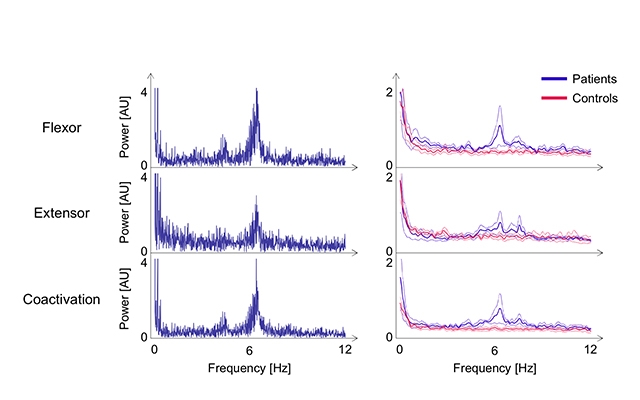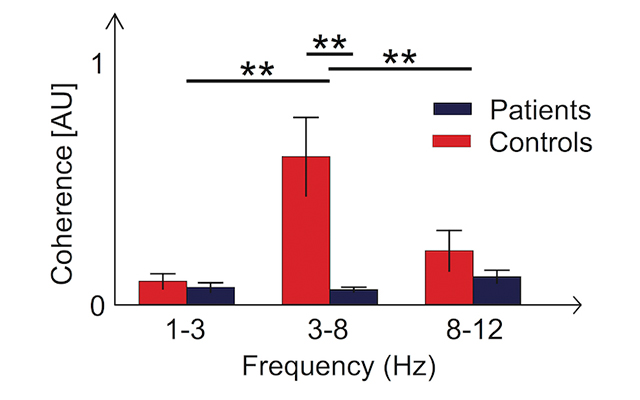 VOLUME 27, ISSUE 3 • October, 2023. Full issue »
VOLUME 27, ISSUE 3 • October, 2023. Full issue »

Examining task-specific tremor in musicians
TSTM is a rare disorder, but it severely affects professional musicians and threatens their careers.
Task specific tremor in musicians (TSTM) is a rare movement disorder that severely affects professional musicians and threatens their career. Until 2009, no studies existed that assessed this condition in musicians. In several studies (Lee et al. 2013, 2014a, 2014c, 2014b, 2015, 2016) we were able to capture characteristics of TSTM in terms of epidemiology, phenomenology, pathophysiology, and treatment options and define it according to the Consensus Statement on the Classification of Tremor of the Movement Disorders Society, which defines an Axis 1: clinical features and and Axis 2: Etiology (Bhatia et al. 2018).

Figure 1: Left panel: EMG-raw data for the flexor and extensor muscle as well as the coactivation of one representative patient with TSTM. Right panel: Mean EMG-activity for the flexor and extensor muscle as well as the coactivation for patients (blue) and healthy controls (red). A peak activation can be seen at around 6 Hz only in patients (Lee et al. 2013). AU=arbitrary units; EMG=Electromyogram; TSTM=Task-specific Tremor in Musicians.

Figure 2: Coherence between EMG-activity and an accelerometer signal of patients with TSTM (blue) and healthy controls (red) in three different frequency ranges. Only in patients is there a significantly higher coherence in the 3-8 Hz frequency range (Lee et al. 2014c). AU=arbitrary units; EMG=Electromyogram; TSTM=Task-specific Tremor in Musicians.
Video 1: Violinist with a task-specific, kinetic, action-induced tremor, induced by performing the corresponding activity (Type-A task-specific tremor): primary bowing tremor, a sub-entity and the most common form of TSTM.
Video 2: A cellist with a position-dependent postural tremor induced by holding the arm as if performing the activity (Type-B task-specific tremor).
Video 3: The same patient as in video 2, holding the unaffected right arm in the same position as the affected left arm, which does not induce tremor.
Axis 1 - Clinical features
TSTM most commonly occurs in middle adulthood and predominantly affects males. It usually develops gradually. A genetic predisposition in the sense of a positive family history seems to play a role. Other risk factors in the genesis of TSTM include previous pain/injury to the affected extremity.
TSTM is a unilateral task- and also position-specific tremor. There are two activating conditions:
-
A task-speific, kinetic, action-induced tremor, induced by performing the corresponding activity (video 1) and
-
A position-dependent postural tremor induced by holding the arm as if performing the activity (video 2).
The first has formerly been described in primary writing tremor as Type-A and the latter as Type-B tremor (Bain et al. 1995).
Video 3 shows the unilateral character of TSTM: It shows the same patient as in video 2 who is holding the unaffected right arm in the same position as the affected left arm, which does not induce tremor.
Furthermore, TSTM is characterized by neuromuscular activity of both flexors and extensors, as well as their co-contraction in the frequency range of 3-8 Hz with a mean frequency of approximately 6.6 Hz. (figure 1). The most common manifestation and nosological subentity is primary bowing tremor in string instrumentalists (video 1). The consistently detectable co-contraction of antagonistic muscles shows a high coherence to the tremor measured with an accelerometer, underlining the relationship between co-contraction and TST (figure 2). In addition, there is an overflow of muscular activity to neighboring muscle groups.
Axis 2 - Etiology
TSTM is an idiopathic and usually sporadic movement disorder.
Treatment
Treatment is symptomatic, with a good response shown to injections of botulinum toxin into the affected muscles or oral medication with beta-blockers or primidone. Less frequently, oral therapy with trihexyphenidyl is effective. Invasive therapy using deep brain stimulation is not regularly used, although there is a successful single case report of an oboe-player (Whitney et al. 2013).
Outlook
Currently, we are investigating neuropathophysiologic correlates in TSTM with functional and structural MRI. The goal is to better understand this disorder and find better treatments in the future that will allow musicians to continue to enjoy playing their instrument.
References
- Bain PG, Findley LJ, Britton TC, Rothwell JC, Gresty MA, Thompson PD, Marsden CD. Primary writing tremor. Brain 118 ( Pt 6): 1461–1472, 1995.
- Bhatia KP, Bain P, Bajaj N, Elble RJ, Hallett M, Louis ED, Raethjen J, Stamelou M, Testa CM, Deuschl G, the Tremor Task Force of the International Parkinson and Movement Disorder Society. Consensus Statement on the classification of tremors. from the task force on tremor of the International Parkinson and Movement Disorder Society: IPMDS Task Force on Tremor Consensus Statement. Mov Disord 33: 75–87, 2018.
- Lee A, Chadde M, Altenmüller E, Schoonderwaldt E. Characteristics of Task-specific Tremor in String Instrument Players. Tremor Other Hyperkinet Mov (N Y) 4: 198, 2014a.
- Lee A, Furuya S, Altenmüller E. Epidemiology and treatment of 23 musicians with task specific tremor. J Clin Mov Disord 1: 5, 2014b.
- Lee A, Tominaga K, Furuya S, Miyazaki F, Altenmüller E. Task-specific tremor in violinists: Evidence of coactivation in the 3 to 8 Hz frequency range: Coactivation of Task-Specific Tremor. Movement Disorders 28: 1890–1892, 2013.
- Lee A, Tominaga K, Furuya S, Miyazaki F, Altenmüller E. Coherence of coactivation and acceleration in task-specific primary bowing tremor. J Neural Transm 121: 739–742, 2014c.
- Lee A, Tominaga K, Furuya S, Miyazaki F, Altenmüller E. Electrophysiological characteristics of task-specific tremor in 22 instrumentalists. J Neural Transm 122: 393–401, 2015.
- Lee A, Voget J, Furuya S, Morise M, Altenmüller E. Quantification of sound instability in embouchure tremor based on the time-varying fundamental frequency. J Neural Transm (Vienna) 123: 515–521, 2016.
- Whitney N, Kareus S, Cetas JS, Chung K, Brodsky M. Bilateral deep brain stimulation targeting ventralis intermedius nucleus to treat a professional musician’s task-specific tremor. Mov Disord 28: 1896–1897, 2013.
Read more Moving Along:






